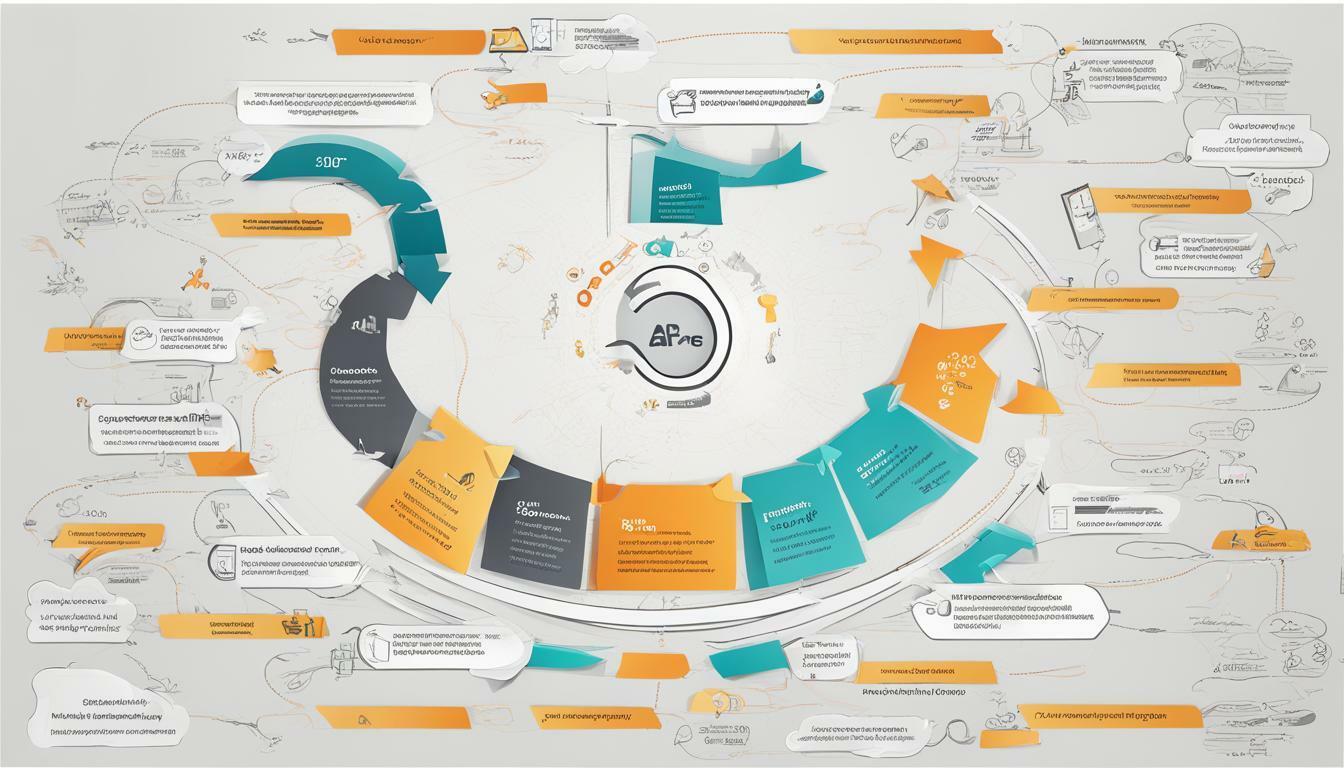
In Agile project management, continuous feedback is a crucial component in achieving success. It facilitates effective communication, collaboration, and timely responses among team members. Without continuous feedback, Agile projects may become stagnant, and teams may miss crucial opportunities for growth and improvement.
Exploring the role of continuous feedback in Agile success highlights its importance in driving project performance and enhancing customer satisfaction. In this article, we will discuss the concept of continuous feedback and its significance in Agile, its benefits, and practical steps to implement effective continuous feedback practices. We will also address common challenges associated with continuous feedback and techniques for measuring and evaluating its effectiveness.
Key Takeaways:
- Continuous feedback is essential in Agile project management.
- Continuous feedback facilitates effective communication, collaboration, and timely responses among team members, driving project performance and enhancing customer satisfaction.
- Benefits of continuous feedback include improved collaboration, faster iterations, and continuous improvement.
Understanding Continuous Feedback in Agile
Continuous feedback is a critical component of Agile project management. Its role in facilitating effective communication and collaboration within Agile teams cannot be overstated.
At its core, Agile is a project management methodology that emphasizes flexibility, iterative development, and customer satisfaction. Continuous feedback is essential to realizing these goals. By providing ongoing insights into team performance, customer needs, and project progress, continuous feedback enables Agile teams to make timely adjustments and improvements.
The feedback loop is a central concept in Agile project management. It involves continuous cycles of planning, execution, and evaluation, with feedback incorporated at every stage. The feedback loop enables Agile teams to identify and address issues early on, continuously improve team performance, and deliver high-quality products to customers.
| The role of continuous feedback in Agile project management: | Benefits of continuous feedback in Agile: |
|---|---|
| • Facilitating effective communication and collaboration within Agile teams • Providing ongoing insights into team performance, customer needs, and project progress • Enabling timely adjustments and improvements | • Improved collaboration • Faster iterations • Continuous improvement • Enhanced customer satisfaction |
Effective continuous feedback practices require a culture of openness and transparency. Agile teams must be willing to give and receive feedback in a constructive and non-judgmental manner. They must also be willing to act on feedback quickly to make improvements.
Implementing Continuous Feedback in Agile Projects
So how can Agile teams effectively implement continuous feedback practices? Here are some key steps:
- Establish feedback mechanisms: create channels for feedback, such as regular team meetings, retrospectives, and project reviews.
- Define clear feedback channels: ensure feedback is specific, actionable, and delivered in a timely manner.
- Foster a culture of continuous improvement: ensure all team members understand the value of feedback and are committed to implementing changes based on feedback received.
- Incorporate feedback into Agile processes: integrate feedback loops into Agile processes by incorporating regular check-ins and evaluations.
By following these steps, Agile teams can create a culture of continuous feedback that drives team performance and customer satisfaction.
The Importance of Continuous Feedback for Agile Success
Effective continuous feedback is the cornerstone of Agile success. It enables teams to identify and address issues early on, allowing for faster iterations and continuous improvement. The benefits of continuous feedback are numerous, from enhanced collaboration and team performance to greater customer satisfaction.
Continuous feedback helps Agile teams maintain their focus on the end goal, constantly improving their process and identifying areas for optimization. It creates a culture of open communication, where team members feel comfortable sharing their thoughts and ideas in a timely manner. This leads to better collaboration, as team members work together to identify and solve problems quickly.
Continuous feedback also promotes continuous improvement, as it allows teams to make incremental changes in response to feedback. This approach ensures that teams are always learning and adapting, increasing their ability to deliver high-quality results.
In terms of Agile team collaboration, continuous feedback is especially important. It allows team members to provide and receive feedback on a regular basis, helping them stay aligned and focused on the project’s goals. This open communication helps to build trust among team members, fostering a positive team dynamic and increasing motivation and engagement.
Overall, the importance of continuous feedback in Agile cannot be overstated. Incorporating continuous feedback practices into an Agile project can lead to faster iterations, enhanced collaboration, and continuous improvement. It creates a culture of open and honest communication, where team members feel empowered to share their thoughts and ideas. As a result, teams are better able to deliver high-quality results that meet the needs of their customers.
Implementing Effective Continuous Feedback Practices
Implementing effective continuous feedback practices is key in ensuring Agile success. Below are some best practices and techniques that can be applied:
Establish feedback mechanisms
Establishing feedback mechanisms ensures that the right feedback is received at the right time. Define the feedback you want and identify the best way to get it. This can be through daily stand-ups, sprint reviews, retrospectives, or informal one-on-one conversations.
Define clear feedback channels
Ensure that there are clear feedback channels in place that are accessible to everyone on the team. Feedback channels can range from physical suggestion boxes to digital platforms such as Slack or Trello. Whatever the method, make sure it’s easy to use and that team members know how to access it.
Foster a culture of continuous improvement
Creating a culture of continuous improvement is essential in Agile environments. Encourage feedback from everyone on the team and ensure that individuals feel comfortable giving and receiving feedback. An open culture of continuous feedback will lead to faster iterations and continuous improvement.
Utilize Continuous Feedback Techniques
There are various techniques for incorporating continuous feedback into Agile processes. These techniques include:
- User Stories: Capture feedback from end-users and incorporate it into the development process.
- Pair Programming: Pairing developers to share feedback can lead to faster learning and better performance.
- Retrospectives: Reviewing feedback from previous iterations can inform future work and help identify areas for improvement.
By utilizing the above practices and techniques, Agile teams can effectively implement continuous feedback, leading to improved collaboration, faster iterations, and continuous improvement.
Overcoming Challenges in Continuous Feedback
While continuous feedback plays a critical role in Agile project management, there are several challenges that teams may encounter when implementing it. Addressing feedback challenges is essential to ensure continuous improvement and enhance project performance. Here are some common continuous feedback pitfalls and strategies to overcome them:
Resistance to Feedback
Feedback is not always easy to receive, and team members may be resistant to constructive criticism. It is essential to foster a culture that values feedback and emphasizes its importance in driving continuous improvement. Leaders should emphasize that feedback is not a personal attack but an opportunity for growth and development. Providing constructive criticism in a supportive and positive way can help to overcome resistance to feedback.
Lack of Transparency
Transparency is crucial for effective feedback. Teams must be open and honest about their feedback, and all feedback should be shared in a transparent and constructive manner. Transparency builds trust and facilitates collaboration, allowing teams to work together to achieve their goals. To promote transparency, teams can establish feedback channels that are open and accessible to all team members.
Ineffective Feedback Loops
Feedback loops can be ineffective if team members do not provide feedback in a timely manner. Teams must establish clear feedback mechanisms and ensure that feedback is provided promptly. Failure to act on feedback can lead to frustration and disengagement among team members, ultimately undermining project performance. To avoid ineffective feedback loops, teams should define clear feedback channels and establish a culture of continuous improvement that prioritizes timely responses.
By addressing feedback challenges, teams can unlock the full potential of continuous feedback in Agile projects. Effective continuous feedback practices can improve collaboration, enhance customer satisfaction, and drive continuous improvement.
Measuring and Evaluating Continuous Feedback Effectiveness
Continuous feedback plays a critical role in driving Agile project performance, but how can you measure its effectiveness? To assess the impact of feedback on project success and customer satisfaction, it is important to gather feedback data and conduct evaluations regularly.
One effective way to measure feedback effectiveness is to define key metrics and indicators that align with your project goals. For example, you may want to measure the frequency and quality of feedback received, the speed of response to feedback, or the impact of feedback on project outcomes.
Another important aspect of measuring feedback effectiveness is to evaluate the feedback mechanisms themselves. Are they easy to use? Are they effective in capturing feedback from team members and stakeholders alike? Gathering feedback about the feedback process can help identify areas for improvement and ensure that the mechanisms are optimized for Agile success.
Finally, it is important to assess the impact of feedback on Agile team collaboration and continuous improvement. Gather feedback from team members about how feedback has contributed to their work and what changes they have made as a result. This can help identify feedback-driven improvements and reinforce the importance of continuous feedback in Agile project management.
Continuous Feedback and Learning Culture
Creating a continuous feedback culture within Agile teams is essential to drive feedback-driven improvement and foster learning. By embracing continuous feedback, individuals and teams can develop a growth mindset that values learning from feedback and using it to drive continuous improvement.
Feedback should be seen as an opportunity for growth and development, rather than criticism. Emphasizing the importance of receiving and giving feedback in a respectful and constructive manner can help create a culture of openness and trust.
Learning from feedback also involves taking action based on the feedback received. This means using the feedback to drive changes and improvements, and actively seeking out opportunities to apply the learning gained from feedback.
Feedback-driven improvement should not be limited to individual learning but should also drive team development. Encouraging team members to share feedback and collaborate on improvements can lead to stronger teamwork and better results.
To foster a learning culture centered around continuous feedback, it is important to provide regular opportunities for feedback and create a safe space for individuals to give and receive feedback. Teams could also consider implementing regular retrospectives to reflect on feedback and drive continuous improvement.
Conclusion
As we have explored in this article, continuous feedback plays a crucial role in achieving Agile success. By providing timely and constructive feedback, Agile teams can increase collaboration, improve project performance, and enhance customer satisfaction.
Implementing effective continuous feedback practices is essential to harnessing the benefits of Agile methodology. Clear communication channels and a culture of continuous improvement are key to fostering a feedback-driven approach to project management.
Measuring and evaluating feedback effectiveness is also critical to ensuring that Agile teams are achieving their objectives. By gathering feedback data and conducting evaluations, they can identify areas for improvement and make data-driven decisions.
The Importance of a Continuous Feedback Culture
Fostering a culture of continuous feedback is essential to creating a learning environment where individuals and teams can grow and develop. By embracing feedback-driven improvement, Agile teams can continuously improve their processes and deliverables, ultimately leading to greater success.
Exploring the role of continuous feedback in Agile success should be a priority for any organization that seeks to improve its project performance and customer satisfaction. By implementing effective continuous feedback practices and cultivating a feedback culture, Agile teams can achieve their objectives and drive lasting success.
FAQ
Q: What is continuous feedback in Agile?
A: Continuous feedback in Agile refers to the ongoing process of providing and receiving feedback throughout the project lifecycle. It involves regular communication and collaboration among team members to improve project performance and achieve success.
Q: What is the role of continuous feedback in Agile?
A: The role of continuous feedback in Agile is crucial. It helps facilitate effective communication and collaboration within Agile teams. It fosters a culture of continuous improvement and enables faster iterations. Continuous feedback also enhances customer satisfaction and ensures timely responses to issues that arise during the project.
Q: What are the benefits of continuous feedback in Agile?
A: Continuous feedback in Agile offers several benefits. It improves collaboration and teamwork, enhances project performance, and enables continuous improvement. It also helps in identifying and addressing issues promptly, leading to faster problem-solving and better customer satisfaction.
Q: How can I implement effective continuous feedback practices in Agile?
A: To implement effective continuous feedback practices in Agile, it is essential to establish feedback mechanisms, define clear feedback channels, and foster a culture of continuous improvement. Incorporating best practices and techniques for continuous feedback into Agile processes can also contribute to its successful implementation.
Q: What are the challenges associated with continuous feedback in Agile?
A: Some common challenges with continuous feedback in Agile include resistance to feedback, lack of transparency, and ineffective feedback loops. These challenges can hinder the effectiveness of continuous feedback. However, strategies such as addressing resistance, promoting transparency, and refining feedback processes can help overcome these challenges.
Q: How can I measure and evaluate the effectiveness of continuous feedback in Agile?
A: Measuring and evaluating the effectiveness of continuous feedback in Agile projects can be done using key metrics and indicators. These metrics can assess the impact of feedback on project performance and customer satisfaction. Gathering feedback data and conducting evaluations are essential techniques to measure the effectiveness of continuous feedback.
Q: How does continuous feedback contribute to a learning culture?
A: Continuous feedback plays a vital role in fostering a learning culture within Agile teams. It enables individuals and teams to learn from feedback and make improvements based on it. A feedback-driven improvement approach encourages growth and development, contributing to a learning culture centered around continuous feedback.








